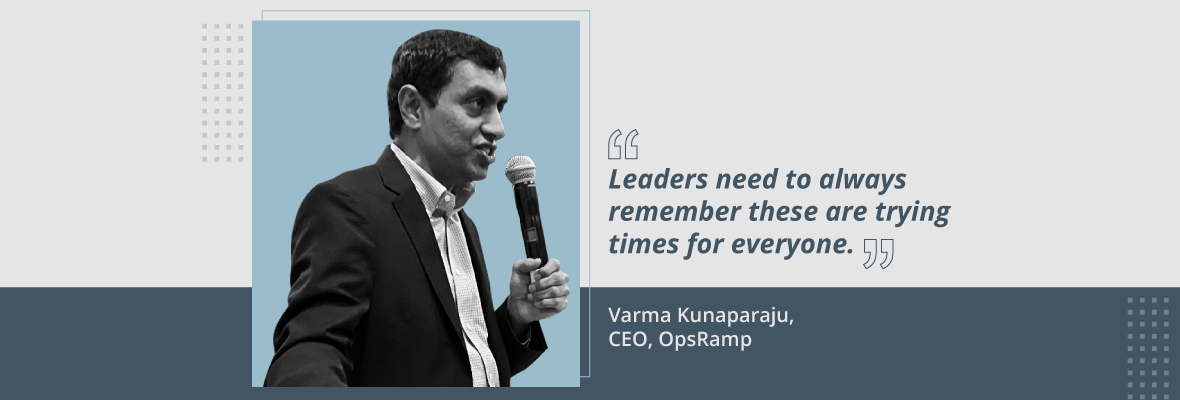Covid-19 has forced IT leaders across the world to rethink and strategize their plans and investments. Despite the economic downturn, surveys have indicated that digital transformation initiatives are still moving forward. Meanwhile ensuring infrastructure resilience and workforce productivity are primary challenges which IT leaders face to survive. After a recent panel discussion with our partner GreenPages and the CTO of MyHealthMath, we spoke with OpsRamp CEO Varma Kunaparaju to discuss what matters most right now in IT leadership and IT operations management.
OpsRamp: We’re now in the next phase of the pandemic. Are IT and business leaders apprehensive about the future or are they bullish about digital transformation?
VK: In my view, business leaders went through three phases of handling the impact of Covid-19. First was the initial shockwave, where they were still positive about the pandemic disappearing from their lives and economies recovering quickly. In the second phase, they came to terms with the fact that the pandemic is going to stay with us at least for a year. Now, IT leaders are entering the third phase where they have accepted the reality that this is going to be a ‘New Normal’ and it’s critical to focus on investing in the right strategies for innovation, while keeping a close eye on costs.
OpsRamp: How has the perception of IT changed since the onset of Covid-19?
VK: IT has become more critical than ever now with businesses moving toward a digital future. A recent survey we conducted showed that despite a spending slowdown due to economic uncertainty, 73 percent of IT operations and DevOps leaders expect to either accelerate or maintain their digital transformation initiatives and projects. This is no longer a choice for IT leaders since the only way they are going to sustain and thrive in a post-pandemic world is by going digital.
OpsRamp: What are companies focusing on now in terms of strategy and technology plans?
VK: IT is no longer just a technology strategy. IT leaders are now expected to help drive new business strategies, especially in those industries which have borne the brunt of the pandemic. The good news is: IT spend continues to be healthy and in some cases, accelerated.
As to where businesses are focusing, I see three broad initiatives:
- How do we make sure that topline business is thriving?
- How do we ensure workforce productivity during remote work?
- How can we maintain operational costs without affecting profitability and the bottom line?
IT leaders are now expected to help drive new business strategies, especially in those industries which have borne the brunt of the pandemic”.
OpsRamp: One of the pain points with large companies is they have accumulated several monitoring tools, some of which may have become redundant and increase technical debt. How would you resolve that?
VK: In IT operations, the focus during the pandemic has been to ensure that business service health and user experience is maintained well so that business units can function. These are extremely critical factors which determine productivity and revenue. With monitoring, CIOs want better visibility across an increasingly distributed and hybrid IT infrastructure, but they are concerned with the sheer number of tools which are redundant and don’t deliver the required service levels. According to a recent 451 Research report, “only 11% of decision-makers are satisfied with their monitoring tools.”
There are three ways you can tackle tool sprawl:
- Tools Rationalization: Assess what you really need to support core business services and consolidate/eliminate redundant or unnecessary tools where you can.
- Automation: Leverage tools with automation to optimize workflows and enable self-remediation of low-risk issues.
- Modernization: Analyze the legacy technology footprint and take modernization seriously. Technology review boards can make this easier and less political. Integrate the tools and technologies that you need to get more value and deeper analytics out of your toolset.
#RampChats @varma1 on Top 3 actions by #ITOps leaders post #Covid19
— OpsRamp (@OpsRamp) August 12, 2020
1) Rationalise tools and reduce #ToolSprawl
2) #Automation - how to optimize, how to self remediate?
3) More than ever, they are looking at #legacy footprint and are taking modernization seriously #CIO pic.twitter.com/kXj9CDhEfl
OpsRamp: In closing, the most important aspect of any organization is the people. These are probably some of the most stressful times we have seen in our lifetime. How can a leader boost employee morale and motivation?
VK: It may sound trite but communication is integral in the world of remote work. By communication, we need both top-down and peer-to-peer communication. At OpsRamp, we’ve organized several ways for people to collaborate, such as with online work sessions and Lunch and Learns where employees can connect and share information casually. We also announced wellness holidays so that employees can take time off to spend with family and de-stress. Leaders need to always remember these are trying times for everyone. It’s important to remain flexible and empathetic.





